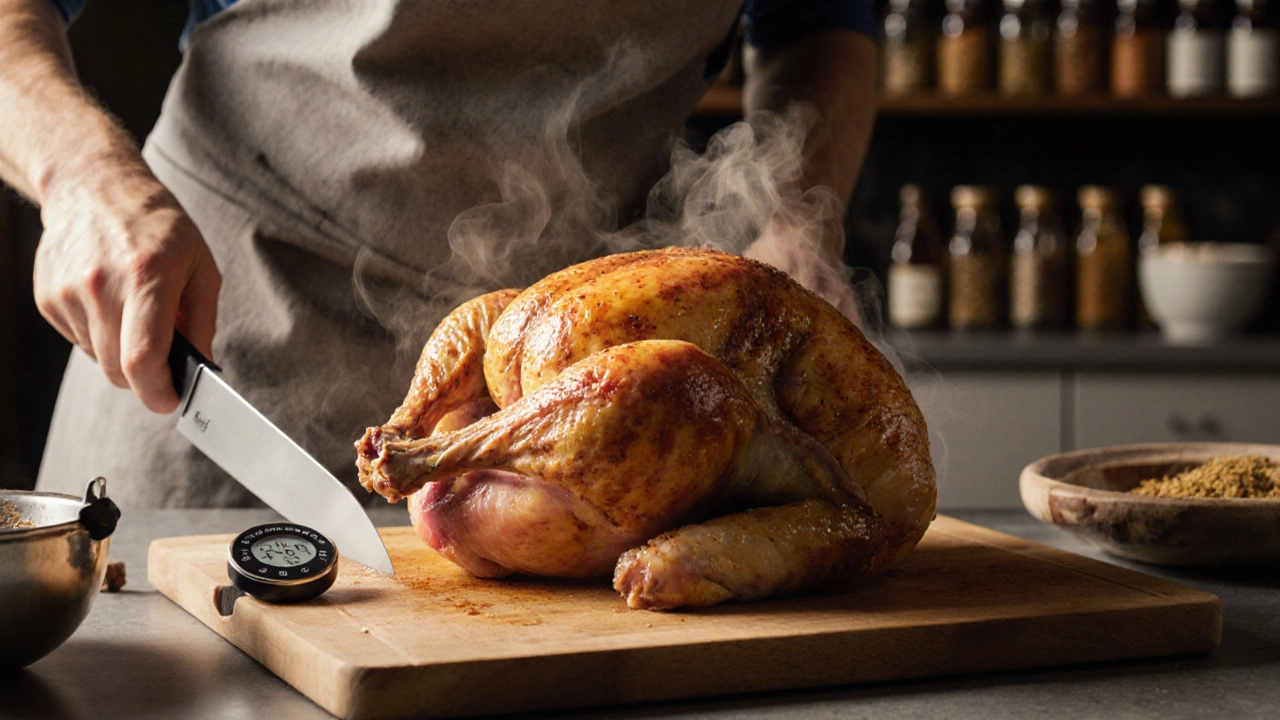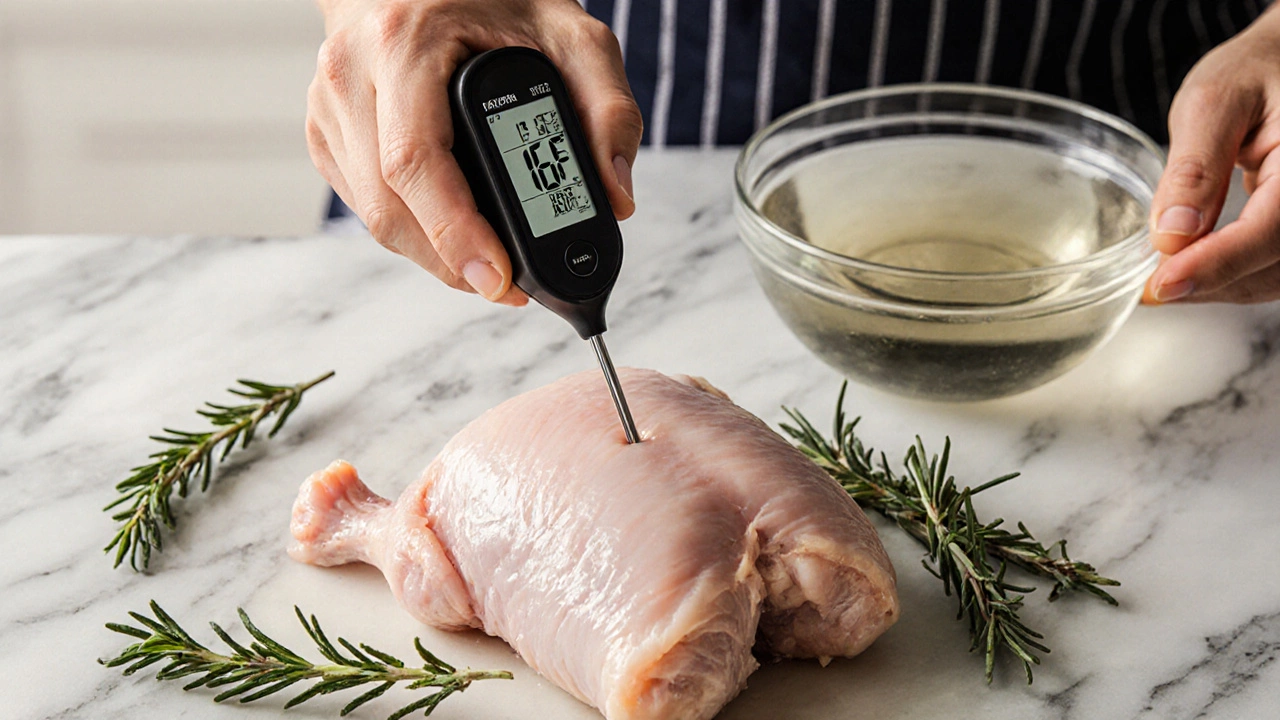Why Is My Chicken Still Pink After Cooking? Causes & Fixes

Chicken Safety Checker
Is Your Chicken Safe?
The USDA says chicken is safe at 165°F (74°C) regardless of color. Enter your measured temperature below to check safety status.
Enter temperature to check safety status.
Why You Might See Pink
- Myoglobin retention in young birds
- Bone marrow seepage during roasting
- Low-and-slow cooking methods
- Acidic marinades
Ever pulled a roasted chicken out of the oven only to see a pink hue lingering in the meat after two hours? It feels like a culinary mystery that can make anyone nervous, especially when food safety is on the line. Below we’ll break down why chicken can stay pink, how to tell if it’s actually safe, and what steps you can take to avoid the pink surprise next time.
Key Takeaways
- Pink color can be caused by myoglobin, bone marrow, cooking method, or lingering bacteria.
- Safe internal temperature for chicken is 165°F (74°C) regardless of color.
- Using a calibrated meat thermometer eliminates guesswork.
- Different cooking techniques (roasting, grilling, slow‑cooking, sous vide) affect how pink appears.
- Simple troubleshooting steps can turn a pink mystery into a confidently cooked meal.
Understanding the science behind the pink helps you cook with confidence and keep your family safe.
What Gives Chicken Its Pink Hue?
Chicken is a type of poultry that turns white when the proteins denature at the right temperature. The pink you sometimes see isn’t always a sign of undercooking. Here are the main culprits:
- Myoglobin: This protein stores oxygen in muscle tissue. In younger birds, especially, myoglobin can stay pink even after reaching safe temperatures.
- Bone marrow seepage: When roasting a whole bird, marrow can ooze out of the bones and tint nearby meat pink.
- Cooking method: Low‑and‑slow methods like slow cookers or sous vide keep the meat moist, often preserving a pink interior.
- Acidic marinades: Ingredients like lemon juice or vinegar can lock in pink pigments.
Safety First: Temperature Beats Color
The USDA’s rule is clear: chicken must reach an internal temperature of 165°F (74°C). That figure kills Salmonella, the most common bacterial threat in poultry. No matter how white or pink the meat looks, if the thermometer reads 165°F, you’re good to go.
How do you measure that reliably?
- Invest in a digital meat thermometer that reads quickly and calibrates easily. Insert it into the thickest part of the breast or thigh, avoiding bone.
- Check multiple spots: the breast, thigh, and near the joint.
- Let the thermometer rest for a few seconds to stabilize before reading.

How Different Cooking Methods Influence Pinkness
| Method | Typical Internal Temp (°F) | Typical Color at Finish | Common Pink Triggers |
|---|---|---|---|
| Oven Roasting | 165‑180 | Mostly white, occasional pink near bones | Bone marrow seepage, myoglobin in young birds |
| Grilling/Charbroiling | 165‑175 | White with charred edges; pink can stay in the center | Rapid surface sear locks in juices, myoglobin |
| Slow Cooker (low 6‑8 hrs) | 165‑170 | Uniform pink‑white mix | Low, steady heat doesn’t break down pigments fully |
| Sous Vide (60‑65°C/140‑149°F, 1‑4 hrs) | 149‑155* | Consistently pink, juicy | Precision cooking keeps myoglobin intact |
*Sous vide relies on pasteurization time rather than a single temperature threshold.
Step‑by‑Step Trouble‑Shooting Guide
- Measure internal temperature with a calibrated thermometer. If it reads 165°F (74°C) or higher, the chicken is safe.
- If temperature is low, keep cooking. Add 5‑10 minutes and re‑measure.
- Inspect the pink area:
- Near a bone? Check the bone’s interior-if marrow is leaking, the pink is harmless.
- In the breast or thigh away from bone? Likely myoglobin or an acidic marinade.
- Consider the cooking method. Low‑and‑slow or sous vide dishes often stay pink; that’s normal if temperature is met.
- Adjust future cooking:
- For oven roasting, raise the heat to 375‑400°F (190‑205°C) during the last 15 minutes to dry out any pink areas.
- For grilled chicken, finish with a brief 5‑minute indirect heat phase.
- If you prefer a fully white look, add a quick sear in a hot pan after slow cooking.
Common Myths About Pink Chicken
Myth #1: "If it’s pink, it’s raw." Wrong. Pink can persist at safe temps, especially with younger birds.
Myth #2: "Juice runs clear = fully cooked." Not reliable. Some juices stay pink while still being safe.
Myth #3: "Cooking longer always fixes pinkness." Overcooking can dry out meat; the real fix is temperature verification.

Pro Tips to Keep Pinkness in Check
- Brine wisely: A simple salt‑water brine reduces myoglobin’s grip, giving a whiter finish.
- Rest after cooking: Let the bird rest 10‑15 minutes; heat carries into the center, finishing the denaturation process.
- Use a two‑probe thermometer: One for breast, one for thigh, so you catch any colder spots.
- Season with herbs that mask pink: Rosemary or thyme adds flavor and visual confidence.
When to Seek Professional Help
If you repeatedly see deep pink in the thigh or drumstick even after hitting 165°F, there could be a faulty thermometer or a misunderstanding of where to insert it. Consider calibrating the device or buying a new one. Persistent off‑color with correct temperature might also indicate a source chicken that’s been injected with a solution containing nitrites-rare but possible in bulk processing.
Frequently Asked Questions
Can pink chicken be safe to eat?
Yes. If the internal temperature reaches 165°F (74°C) and stays there for at least 15 seconds, the meat is safe even if it looks pink.
Why does chicken stay pink near the bone?
Bone marrow can ooze out during cooking, staining the surrounding meat pink. The heat still reaches safe levels; the color is just a pigment transfer.
Should I cook chicken longer if it’s pink?
Only if the thermometer reads below 165°F. Extending cooking time without checking temperature can dry out the meat.
Does marinating in acidic liquids keep chicken pink?
Acids can lock in the pink hue by altering the protein structure, but they don’t affect safety. Use a thermometer to confirm doneness.
What’s the best thermometer for checking chicken?
A digital instant‑read probe with a stainless‑steel tip and a clear display is ideal. Look for models that allow calibration and have a temperature range up to 500°F (260°C).
Next time you pull a chicken out of the oven, remember that pink chicken isn’t automatically a red flag-temperature is. Armed with a reliable thermometer and a bit of science, you can turn that pink surprise into a perfectly safe, delicious dinner.